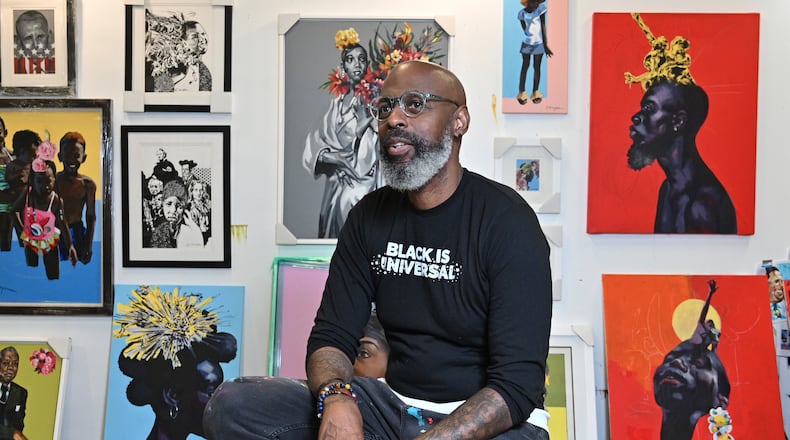The first in-person show at this definitive West End institution after more than a year of COVID-19, “Departure by Charly Palmer” is also the artist’s first solo exhibition at Hammonds House Museum.
The exhibition shows a 30-year range of Palmer’s style including recent paintings that move between realism and abstraction, lending a universality to his images of Black experience. His portrait of two little girls in “Outsider” (2017), shown separated from some yearned-for thing by a high metal fence, is a typically haunting image in that vein. That painting is the progeny of Gordon Parks’ photograph “Outside Looking In” from 1956 of Black children in segregated Mobile, Alabama, with their hands gripping a chain link fence and looking toward the playground whose pleasures they have been denied.
In many ways Palmer’s work is a spiritual descendent of the influential photographer Parks, in showing both the strength of Black people along with their vulnerability. Parks’ famous image “American Gothic” of a cleaning lady posed with mop and broom in front of the American flag finds another echo in Palmer’s painting “America Was.” That work shows Hattie McDaniel, embodiment of the racist “mammy” stereotype in “Gone With the Wind,” seated with the American flag behind her. Both artists depict women funneled into playing a particular role in life because of a lack of options.
Credit: Charly Palmer
Credit: Charly Palmer
Abstraction-adjacent — like timeworn Polaroids — those paintings in acrylic are some of Palmer’s strongest in this far-ranging exhibition whose biggest deficit is one beyond the artist’s control in the show organizers’ failure to include the dates of works. It’s a strange oversight in a retrospective that hinges on viewers registering shifts in style and content over his career.
The artist pivots again in early works like “King Shabazz” from 1991 in a busy, collaged style (my least favorite phase of Palmer’s many iterations) and then again with the bold color-blocked works of Black strength and resilience in the gorgeous diptych painting “Be a Warrior” (2020) of a contemporary Black man juxtaposed with a traditional African mask. That phase moves Palmer’s content from the real, lived world, into an iconic, spiritual dimension of Afrofuturism and imagined worlds where Palmer significantly depicts women with as much strength as men.
Credit: Charly Palmer
Credit: Charly Palmer
Palmer is at his most celebratory and hopeful when he embodies the strength of Black resilience and dignity in portraits which depict athletic or pregnant, powerful and questing Black figures. In many works, including a video in the rear gallery space, that humanistic approach is orchestrated to Atlantan Okorie “OKCello” Johnson’s musical compositions which accompany the video or can be activated with QR codes attached to key artworks.
Those later works draw their seductive presence from a juxtaposition of powerful Black bodies with intense color-blocked backgrounds that recall Amy Sherald and Fahamu Pecou.
“Departure” proves Palmer’s mettle as an undeniably expert storyteller and illustrator. His work as a visual artist distills his ideas just as concisely as his commercial work for Rolling Stone or for the cover of Time magazine “In Her Eyes” (on view in the Hammonds show) of a young women depicted amidst a miasma of political protest.
Credit: Charly Palmer
Credit: Charly Palmer
Despite his versatility, certain tropes continue throughout Palmer’s oeuvre, including the garlands of flowers as gestures of remembrance in his image of George Floyd, and in the floral crowns and sashes that adorn his Black figures. Those transcendent flowers ushering figures into the afterlife coexist with Palmer’s glittering swaths of twinkling night sky to hint at a cosmos beyond the degradations of existence on earth.
Another constant in his paintings: American flags. In Palmer’s hands its stars and bars are muzzles, falling tears, blindfolds and bloody lashes. A blend of sorrow, rage and spirituality can make Palmer feel like a strange but compelling hybrid of Norman Rockwell sentimentality and the good troublemaking of an artist like Dread Scott. America in all of its beauty, contradictions and despair is presented in “Departure” through the filter of the Black experience.
ART REVIEW
“Departure by Charly Palmer”
11 a.m.-5 p.m. Fridays and Saturdays; noon-5 p.m. Sundays. Through Aug. 1. $10; $7 for senior citizens (62+); $5 for students, artists, poets, writers; free for ages 12 and younger and museum members. Hammonds House Museum, 503 Peeples St. SW, Atlanta. 404-612-0481, hammondshouse.org
Bottom line: An illuminating look at an Atlanta artist who has addressed both racial injustice and transcendent hope in far-ranging work.
About the Author
Keep Reading
The Latest
Featured





